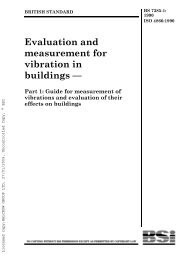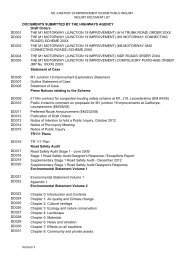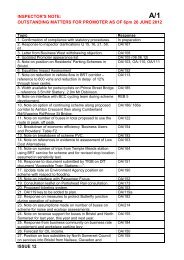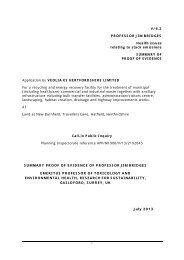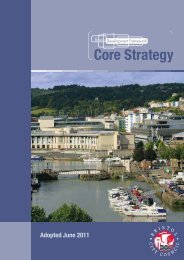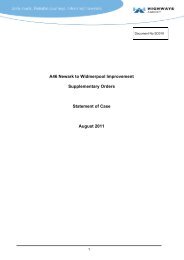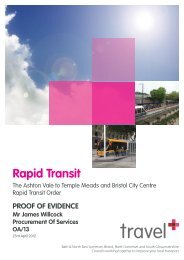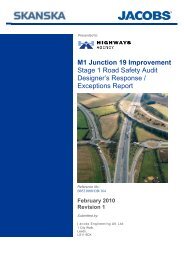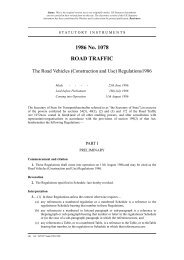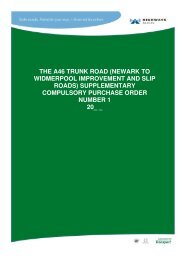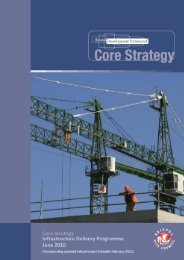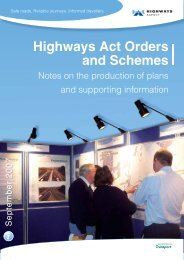Chapter 9: Road drainage and the water environment
Chapter 9: Road drainage and the water environment
Chapter 9: Road drainage and the water environment
You also want an ePaper? Increase the reach of your titles
YUMPU automatically turns print PDFs into web optimized ePapers that Google loves.
M1 JUNCTION 19 IMPROVEMENT<br />
ENVIRONMENTAL STATEMENT VOLUME 2<br />
CHAPTER 9 – ROAD DRAINAGE AND THE WATER ENVIRONMENT<br />
incident, although <strong>the</strong> licensed supply is probably too distant to receive any impact.<br />
Ground<strong>water</strong> within <strong>the</strong> non-aquifer in <strong>the</strong> study area is still potentially at risk from pollution,<br />
although <strong>the</strong> consequence of such pollution is considerably reduced compared to <strong>the</strong> minor<br />
aquifer.<br />
9.6.40 Ano<strong>the</strong>r source of potential contamination is remobilisation of contaminated l<strong>and</strong>. The only<br />
known source on site is <strong>the</strong> area of <strong>the</strong> former Cleanaway l<strong>and</strong>fill site. However, <strong>the</strong><br />
junction improvement has been designed to avoid <strong>the</strong> area. Thus <strong>the</strong> risk of ground<strong>water</strong><br />
pollution by disturbance is negligible. <strong>Chapter</strong> 5, Materials, deals with this issue in more<br />
detail.<br />
Operation<br />
9.6.41 A system of ditches <strong>and</strong> filter drains exists to intercept <strong>and</strong> divert ground<strong>water</strong> at <strong>the</strong><br />
existing highway boundary, <strong>and</strong> it is proposed to maintain <strong>and</strong> supplement this system as<br />
appropriate to control ground<strong>water</strong> levels as necessary along <strong>the</strong> highway. Filter drains<br />
would be used at <strong>the</strong> base of embankments. Minor levels of infiltration to ground<strong>water</strong> may<br />
occur. However, no significant change to ground<strong>water</strong> levels or discharges is likely to arise<br />
from <strong>the</strong> operation of any of <strong>the</strong> junction options.<br />
9.6.42 Carriageway runoff is to be collected in <strong>drainage</strong> ponds <strong>and</strong> discharged to surface <strong>water</strong>. It<br />
is proposed that <strong>the</strong> ponds would be lined to prevent potentially contaminated <strong>water</strong><br />
migrating down to <strong>the</strong> underlying ground<strong>water</strong>. Operational <strong>drainage</strong> is not anticipated to<br />
pose a significant pollution threat to ground<strong>water</strong>; <strong>the</strong>refore a quantitative discharge to<br />
ground<strong>water</strong> assessment has not been undertaken. However, potential contaminants<br />
include List 1 substances such as herbicides from verges / embankment vegetation control<br />
applications in addition to oil <strong>and</strong> fuel.<br />
9.6.43 Recharge to ground<strong>water</strong> would be reduced due to <strong>the</strong> increase in highway area <strong>and</strong><br />
associated interception of incident rainfall, <strong>and</strong> subsequent <strong>drainage</strong> to surface <strong>water</strong>s. The<br />
overall reduction in recharge of ground<strong>water</strong> is not considered to result in significant<br />
impacts because <strong>the</strong> increase in road area on <strong>the</strong> minor aquifer, as a proportion, is<br />
negligible. However, as good practice, reduction in infiltration should be limited wherever<br />
possible. Figure 9.1 shows <strong>the</strong> extent of <strong>the</strong> minor aquifer <strong>and</strong> non-aquifer in <strong>the</strong> vicinity of<br />
<strong>the</strong> junction.<br />
9.6.44 Some works, such as bridges, would involve piled foundations through areas of <strong>the</strong> minor<br />
aquifer. These piled foundations may cause localised changes to ground<strong>water</strong> flow <strong>and</strong><br />
provide a potential downward migration pathway. ‘Contaminated’ l<strong>and</strong> should not be piled<br />
through, <strong>and</strong> <strong>the</strong> type of pile may also be chosen to restrict downward migration. There is<br />
no piling proposed in <strong>the</strong> vicinity of <strong>the</strong> former Cleanaway l<strong>and</strong>fill site.<br />
Flood Risk<br />
9.6.45 The A14 part of <strong>the</strong> site is situated in Flood Zone 3a High Probability, as defined by<br />
Planning Policy Statement 25 (PPS 25). The widening of <strong>the</strong> A14 would displace <strong>the</strong><br />
existing floodplain, <strong>and</strong> would be mitigated by introducing floodplain compensation areas,<br />
as described in Section 9.5 <strong>and</strong> illustrated on Figure 3.13. With <strong>the</strong> compensation in place,<br />
<strong>the</strong>re would be no increase in flood risk. A Flood Risk Assessment 48 has been carried out in<br />
accordance with PPS 25 <strong>and</strong> is at Appendix C.<br />
9.6.46 Two bridleway crossings over <strong>the</strong> River Avon would be constructed within <strong>the</strong> 1 in 100 year<br />
floodplain. These structures would be at risk of flooding, <strong>and</strong> would not be passable during<br />
flood events. They have been allowed for in assessing <strong>the</strong> flood compensation required.<br />
B0531000_ID_70-EIA Vol 2 Chap 9 <strong>Road</strong> Drainage <strong>and</strong> <strong>the</strong> Water Environment Final Rev 4.doc Page 33



